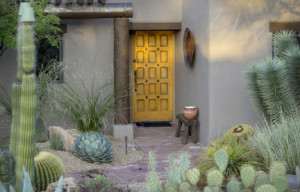Xeriscape Landscaping in Sonoma County
 Xeriscape Why?
Xeriscape Why?
Xeriscape became a word invented by Denver Water Department when forbidding watering in summer. Sonoma residents must:
- select plants appropriate to your climate,
- mulch plants to help them retain moisture
- care for your plants properly
- keep plants healthy
- Plant shrubs, trees and other attractive plants where grass used to be.
The foregoing basics reduce water consumption 60 percent. Instead of a monotonous expanse of lawn in shades of green to brown, your yard can become rich with variety and interesting to observers. Filling your yard with a variety of hardy drought tolerant plants indigenous to your area is making a pact with Mother Nature that you are on her side. You are now going to help her with a bounty of beautiful plants she worked over 1,000 years to perfect for your exact piece of land.
Prepare the Yard Soil
- Pick up a fistful of thoroughly wet soil from your yard and squeeze it into a ball. The ball will stay formed or will crumble apart.
- Add organic material to your soil if the ball of dirt crumbled quickly. Compost or manure helps crumbly soil retain moisture.
- Add sand or ground bark to the soil if the ball of dirt formed a tight, hard ball. Hard, clay soil allows all water to run off quickly before it even has a chance to reach a plant’s roots.
Grow Plants Nature Designed for Sonoma
- Grow plants native to the Sonoma parched earth. They adapted mechanisms over hundreds of years to tolerate and cope with your weather and water gauge, so require little watering. Landscape companies can recommend plants for you so that your unique taste can still be displayed in your xeriscape garden.
- Plant trees suited to dry landscaping, such as California buckeye, which though their seeds are poisonous, make great shaped trees. The U.S. Department of Agriculture plant hardiness dictates zones 6a and higher for Sonoma.
- Plant drought-tolerant xeriscape shrubs like California wild lilac, best in USDA zones 5b or higher with lovely flowers. California wild lilac can grow in either full sun or partial shade.
- Choose drought-tolerant ornamental grass like blue lyme for full sun or light shade. This clumping grass is very hardy, with gray-blue foliage and grows up to 4 feet tall with very little water.
- Plant xeriscape succulents in your hard that will store water in fleshy leaves and need little water from you. The Century plant, or Agave Americana, grows well in USDA Zones 9a through 11 in full raging sun or a little shade. Reaching 8 feet in height and 12 feet wide. They provide a focal point if you just make sure you have a safe distance between its spiny leaves and foot traffic.
Follow Xeriscape Principles
- You must cover your entire garden with a layer of mulch or compost so that the need for moisture due to evaporation is nil. Compost has nitrogen, giving plants nutrition and improving texture of your xeriscape yard soil.
- Water in early morning or evening to minimize any evaporation. Drip irrigation systems are the most effective method for Sonoma.
List of Zero to Low Water Need Plants for Sonoma Area
There are many drought tolerant plants needing no supplemental summer water once established. While these are uber-drought tolerant xeriscape plants, some will do a bit better with some water. Some fine shrubs that meet these criteria are:
- Arbutus Onedo
- Acca Sellowiana
- Baccharis Pilularis
- Buxus
- Callistemon spp.
Contact your local landscape company to learn the multitude of xeriscape plants that can beautify your home without watering!
Tagged: DK Landscaping, drought tolerant, landscape, landscaping, organic, Sonoma County, xeriscape
Both comments and pings are currently closed.





